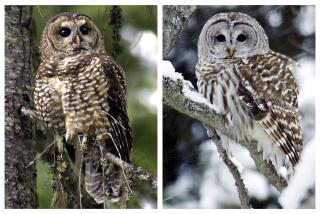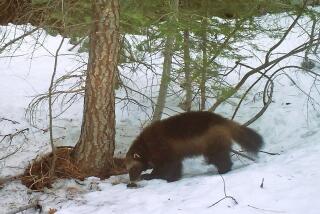Isle Royale wolves at risk from climate change, isolation
- Share via
On an icy island wilderness near the tip of Minnesota, a female gray wolf’s demise has added to the debate about whether authorities should try to save the wolves of Isle Royale National Park.
Once, wolves could regularly move on and off the island along ice bridges to find fresh mates. Now, researchers say, climate change has made ice bridges rare on Lake Superior, and the increasingly isolated wolf population has grown weak through inbreeding. The death of the wolf nicknamed Isabelle -- who had apparently crossed an ice bridge in search of a mate -- reduced the known population to nine.
The researchers have called on the federal government to interfere with a wilderness area -- a drastic break from tradition that they say has been forced by climate change. They want the National Park Service to import fertile wolves from robust neighboring populations.
“To preserve a healthy ecosystem with climate change, we at times are going to have to intervene, and that’s a hard thing to wrap our heads around,” said Michael Nelson, an Oregon State University professor who specializes in environmental ethics and philosophy. “You don’t just wake up one day to that realization and change what you do.”
That proposal is controversial, however, and the National Park Service has not decided what to do.
The carcass of 5-year-old Isabelle, one of three potentially fertile Isle Royale wolves, was found Feb. 8 and announced this week. An initial autopsy failed to determine her cause of death.
At least, researchers say, three of the island’s surviving wolves are less than a year old -- a welcome development after a worrisome year without any pups.
“That gives us some breathing room,” Nelson told the Los Angeles Times. “But you want to make sure you don’t waste that space, and that you instead use that space to do the hard thinking.”
Isle Royale is a rare place where predator and prey, wolves and moose, can fend for themselves without interfering predation from humans or bears. The matchup has been closely tracked since 1959. The park gets fewer visitors in a year than Yosemite National Park sees in two days, but thanks in part to scientists, Isle Royale has more repeat visitors than anywhere else.
Moose migrated to Isle Royale around World War I, and wolves after World War II.
Two decades ago, the wolf population dipped from 50 to about a dozen. Researchers won approval to install tracking devices on some of the wolves and draw their blood.
Researchers discovered that the wolves had been ravaged by a disease brought to the island by visitors’ pet dogs. All they could do was wait to see if the population would rebound. It did, reaching 30 before falling again about five years ago.
Now, climate change is further stressing the wolves. Once, solid ice bridges to Minnesota happened seven out of 10 winters. Now, it’s more like once a decade, including in 2008 and two weeks this winter.
By 2040, ice bridges won’t exist, said John Vucetich, a Michigan Tech University population biologist who studies the wolves and moose of Isle Royale.
Inbreeding has led to genetic abnormalities, including deformed backs. Vucetich and his colleagues said that could be remedied by importing wolves from abundant packs in Minnesota or Ontario. That would also ensure that Isle Royale’s population doesn’t disappear, researchers say.
If the National Park Service decides to let nature take its course and the wolves die out, researchers warn, the moose population could boom and destroy the park’s ecosystem.
“We have certain perceptions about what constitutes a healthy landscape, and typically we don’t consider dramatic, out-of-whack cycles in that,” Nelson said, referring to what might come of moose unchecked by wolves.
Speaking to The Times from the national park, Vucetich said that he, Nelson, ecologist Rolf Peterson and others who say man should intervene have faced three types of critics.
One group insists on a hands-off policy toward wilderness areas, regardless of the consequences. They worry that intervening in Isle Royale would open the floodgates nationwide. And they say researchers would lose the ability to study the island’s small gene pool if more wolves were introduced.
Others say island fauna populations shift all the time, and nature should prevail despite the observations that might be lost without the unique predator-prey ecosystem.
Then there are the optimists, who say everything will work out.
Vucetich says he prefers the activist approach because “there’s some things we can resist and hang on to and not let climate change take away.”
He says the cost of protection -- moving some wolves to the island -- is low and the benefit -- preservation of the status quo despite climate change -- is great. “Genetic rescues” have been successful, including with Florida’s panthers. The action is also the option with the least risk of causing irreparable harm, Vucetich said.
“That the parks officials are having trouble with this doesn’t bode well for the future, because this one is an easy one,” he said. “There’s a lot of things like this coming soon.”
Phyllis Green, Isle Royale’s park superintendent, says officials are summarizing the more than 1,000 public and expert comments they’ve gathered in the last two years. She expects to release a report in the late spring.
“We’re going to take our time and make the most right decision we can,” Green said. “Try as we might as humans to predict what’s going to happen, the more we know, sometimes the clearer the path -- but sometimes it’s still a trade-off.”
Follow LATimes National on Facebook
RELATED:
Wolf protection plan raises hackles in Southwest
Alaska wolves need protection, wildlife activists say
More than 550 wolves killed in Rockies by hunters, trappers
More to Read
Sign up for Essential California
The most important California stories and recommendations in your inbox every morning.
You may occasionally receive promotional content from the Los Angeles Times.











